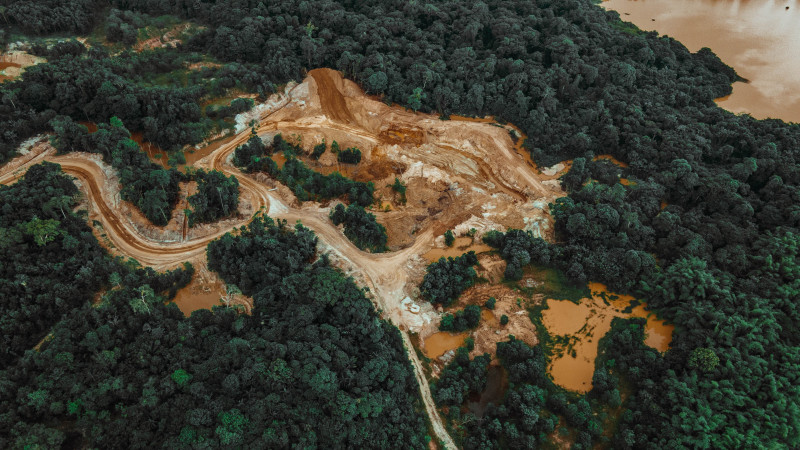
By Sarah Hitchcock
To say that the Amazon rainforest has been used and abused is an understatement. It is well established that deforestation is being fuelled by logging, agriculture, cattle ranching, mining, oil extraction, and dam-building. However, how these practices are directly linked to activity further down the supply chain is less understood. In recent years, more attention has been given to this issue in order to hold companies and organisations directly accountable for the destruction of the defenceless Amazon rainforest.
While there have been previous reports examining the link between industries such as the automotive industry and deforestation, a recent study has examined the extent to which the fashion industry is responsible for the deforestation of the Amazon rainforest. The study was conducted by Stand.Earth, a non-profit organisation focused on conservation, alongside the Stand Research Group. The report was released in November 2021 and is titled “Nowhere to Hide: How the Fashion Industry is Linked to Amazon Rainforest Destruction”. To demonstrate how the fashion industry is directly related to deforestation of the Amazon, the report analyses customs data and provides an interactive website that illustrates the full leather supply chains of numerous fashion brands and their link back to the Amazon. In doing so, it is easy to visualise the direct link between the fashion industry and the destruction of the rainforest.
The study was extremely critical of JBS, Brazil’s largest beef/leather company. Most notably, they illustrated how JBS provides leather processors that in turn supply fashion brands such as Coach, H&M, LVMH, and many more. The report explicitly states, “All companies sourcing directly from JBS or indirectly from JBS via leather processors are therefore linked to deforestation of the Amazon rainforest”. Currently, there seems to be a central focus on sustainability within the fashion industry, which begs the question: Has the leather industry been forgotten about within critical sustainability talks in the world of fashion?
While the headlines have been dominated by stories linking palm oil and soybean production to dangerous levels of deforestation, the leather industry’s association with beef production has gone relatively under the radar by comparison. The relationship between beef production and leather is not overwhelmingly complex, yet has gone vastly misunderstood and ignored. Defenders of the meat industry are quick to label leather a “by-product” of beef production and therefore claim it has no direct responsibility for the negative environmental impacts of the beef industry. On the other hand, Peta claims that leather is a “co-product” of the unstainable meat industry and should hold full accountability for the environmental destruction that the industry is associated with.
Global Canopy releases an annual report, The Forest 500 Report, that tracks the performance and policies of 350 companies closely linked to deforestation. Their 2021 report revealed that when compared with industries like pam oil, timber, and soy, the leather industry had very few deforestation commitments in place, let alone implementing them. This report has fueled concerns amongst environmentalists that more needs to be done to address the leather industry's role in the deforestation of the Amazon. Without immediate action, the livelihoods of indigenous people and the conservation of thousands of plants and animals are put further and further at risk.
Taking action on this issue would consist of demanding more traceability, transparency, and accountability. One initiative taking on this task is Textile Exchange. Textile Exchange has set up a framework, the Leather Impact Accelerator, which places existing industry tools into a coherent package to enable leather supply chain members to engage in sustainable and ethical production practices. The framework takes into consideration animal welfare standards, leather production standards, and deforestation protocols to ensure that companies have an efficient and straightforward way to curb any unnecessary negative environmental impacts.
In terms of what the consumer can do to address this issue, the opportunity to take effective action is fairly limited. It is possible to check a particular brand's leather sourcing policies, but the effectiveness of this action is uncertain due to the lack of transparency and traceability within the leather industry supply chain. In other words, there needs to be a top-down approach to change as opposed to responsibility being placed on the individual third-party consumer. In light of both Stand.Earth and Global Canopy’s new reports, brands should feel encouraged to demand higher standards of leather sourcing and be proactive in mapping the leather supply chain their brand is associated with. In doing so, further deforestation can be avoided while simultaneously allowing consumers to make more environmentally friendly choices.
The Amazon is the world’s richest, and most biologically diverse region. It is home to some of the rarest and most beautiful creatures in the world. It is bursting with life, some that has not yet been discovered by scientists. Hence, there is an abundance of opportunities to utilise plants and animals for medicinal purposes, research, or just to develop a deeper understanding of nature. To allow deforestation and destruction of such a precious resource to continue is, to put it lightly, ecocide. We must avoid this at all costs.